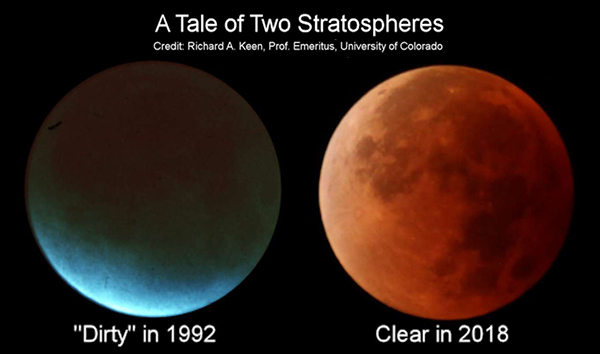
Volcanic eruptions can affect global warming—or cooling. And one of the ways we measure their impact is by looking at a lunar eclipse.
To understand this strange connection, we need to know a bit about Earth’s atmosphere.
The lowest part, the troposphere, extends from the surface up 4 to 12 miles. It’s where Earth’s weather happens.
The stratosphere, above that, is dry and less active.
Dust and ash particles carried into the troposphere by volcanoes, fires, or other sources will quickly fall or be rained out.
But when a large volcano erupts, it blasts ash and gas through the troposphere into the stratosphere.
There, sulfur gas forms microscopic droplets of sulfuric acid. These “sulfate aerosols” can remain suspended for years.
One way scientists measure them is by looking at lunar eclipses. If they’re murky and dim, the stratosphere is clouded with aerosols. If they’re bright and defined, the stratosphere is clear.
Large volcanoes in the past have put up enough aerosols to reflect the sun’s heat and cool the surface of Earth by as much as 1°F.
But in the last two decades, the stratosphere has been remarkably clear, which has allowed more solar energy to reach Earth.
Some scientists estimate this has caused half the global temperature increase seen during this period.
Another example of how Earth’s processes are linked in surprising and complex ways.
Background
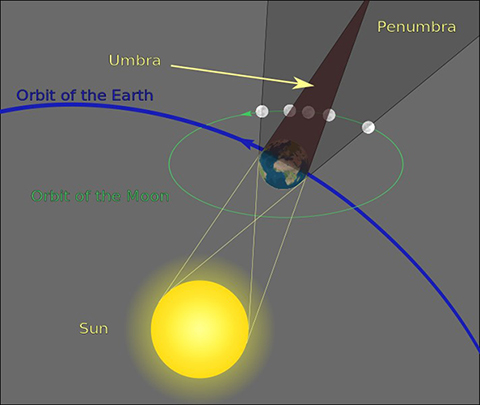
Synopsis: One way to check on the health of our stratosphere is to view a lunar eclipse. Ash from active volcanoes can create aerosols that pollute the stratosphere and dim eclipses.
- A lunar eclipse occurs when the moon passes behind Earth and through its shadow. Such eclipses can last for hours since Earth and its shadow are so much larger than the sun in the lunar sky.
- If the moon passes through the edge of Earth’s shadow, the penumbra, the sun is only partially blocked by Earth, so some of the light of the sun illuminates the moon. Such a partial lunar eclipse only dims the moon slightly.
- Once or twice a year, the moon passes through the center of Earth’s shadow, the umbra, creating a total lunar eclipse.
- Even during a total eclipse, the moon is still lit by sunlight that is refracted into the umbra as it travels through the atmosphere.
- If Earth had no atmosphere, the moon would be completely black during a total lunar eclipse. Instead, Earth’s atmosphere bends a fraction of the sun’s light toward the moon and filters out most of the blue-colored light. The dim light that reaches the moon is deep red or orange, and creates the beautiful views of the moon visible during a total eclipse.
- The visual clarity of lunar eclipses varies markedly depending on clouds, dust, and aerosols in Earth’s atmosphere.
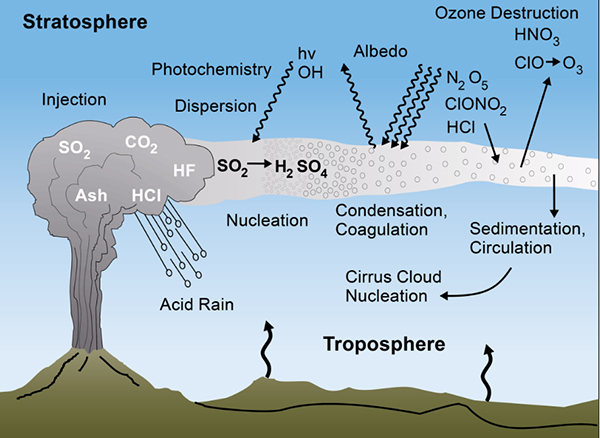
- Earth’s atmosphere consists of several layers:
- The troposphere is where we live.
- All of our weather, winds, and clouds occur in this layer, so it can be very turbulent.
- The temperature of the troposphere decreases as you go upward, to a frigid -60°F (-51°C).
- The troposphere starts at Earth’s surface and extends upward about 4–12 miles (7–20 km), thickening toward the equator.
- The stratosphere is Earth’s protective blanket; it contains 90 percent of Earth’s ozone.
- Ozone absorbs ultraviolet light from the sun, shielding Earth.
- Absorption of the damaging UV radiation heats the stratosphere, causing temperature to rise.
- The stratosphere warms progressively from the cold top of the troposphere up to about 31 miles (50 km), where the temperature averages a balmy 5°F (-15°C).
- The increasing temperature profile within the stratosphere causes stratification of the very dry air.
- No weather occurs in this layer because the temperature stratification prevents vertical convection and mixing.
- Commercial jetliners may fly near the base of the stratosphere to decrease flight turbulence.
- Beyond the stratosphere, temperature plummets once again to the top of the mesosphere, about 50 miles up, where temperatures may reach -200°F (-129°C). Above that height, temperatures in the thermosphere and the exosphere may reach over 1000°F (538°C), but the “air” there is so thin that such temperatures are almost imperceptible.
- The troposphere is where we live.
- When explosive volcanoes erupt, they eject ash and gases into the troposphere; if they are explosive enough, these materials reach the stratosphere.
- Ash falls rapidly from the troposphere and stratosphere because of gravity.
- The troposphere cleans itself in weeks to months as weather systems flush CO2 and water vapor back toward Earth’s surface.
- With no vertical mixing or weather occurring in the stratosphere, gases react with water vapor to create aerosols that are dispersed horizontally within its stratified layers and may reside there for months or even years.
- Sulfur aerosols are tiny (20–150 times smaller than a human hair) droplets of sulfuric acid that are particularly effective at reflecting solar radiation.
- Aerosol reflection of sunlight can cool Earth and dim light transmitted through the stratosphere for as long as the aerosols circulate.
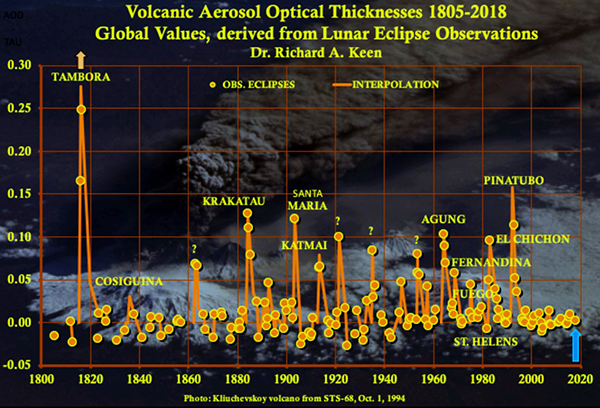
- The most explosive volcanic eruption in the past 100 years was the 1991 eruption of Mt. Pinatubo in the Philippines.
- It ejected 20 million tons of sulfur dioxide more than 37 miles (60 km) into the stratosphere.
- Global temperatures dropped by 1.1oF (0.6oC) and stayed below normal for about 3 years.
- Pinatubo aerosols in the stratosphere had another effect—they limited the brightness of the eclipsed moon during the 1992 lunar eclipse so that it was barely visible.
- Researchers track the health of the stratosphere by measuring global aerosol optical depth (AOD) using the comparative brightness of lunar eclipses. Dr. Richard Keen, Professor Emeritus at the University of Colorado, has assembled and studied reports of lunar eclipse brightness since 1800 and reports the following:
- A volcanically active period from 1980 to 1995 resulted in dimmer lunar eclipses; since 1996, however, lunar eclipses have demonstrated high AOD, indicating that the visual clarity of the stratosphere remains high.
- This 22-year run since 1996 is the longest period of high visual clarity of the stratosphere since the 25 years between 1837and 1862.
- A clear stratosphere lets more sunlight in to warm Earth.
- Dr. Keen calculates that since 1995, the amount of sunlight actually reaching the ground through the clear stratosphere has increased by 0.6 watts per square meter—the equivalent of around 0.27oF (0.15 oC).
- This warming may account for about half of the ~0.54oF (0.3 oC) total warming seen in global satellite temperatures.
- Total lunar eclipses happen about once per year; about half of these are visible from any point on Earth.
- To check on future eclipses in your town, try out this When Is the Next Lunar Eclipse? page from Timeanddate.com.
- A lunar eclipse will be visible in the Americas on the night of January 20–21, 2019.
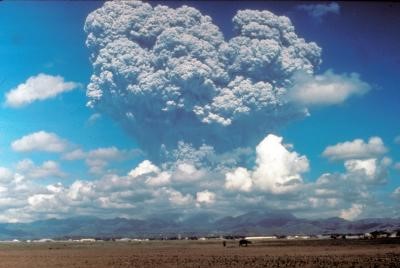
Credit: USGS

